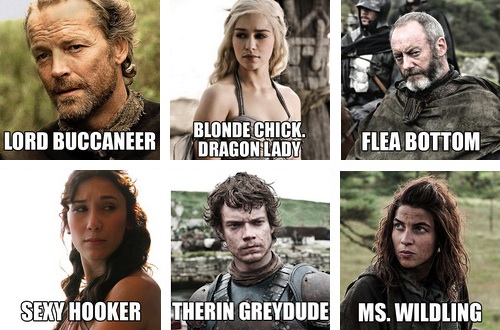Nicknames can be a mixed bag—sometimes they signal affection, admiration, or acceptance, and sometimes they’re a form of taunting, a devastating insult that lingers like a malicious ghost, inescapable. In the Song of Ice and Fire series, nicknames can be obvious, or ironic, affectionate or scathing, incredibly apt or impossibly unfair, but whether merited or misleading, such names often provide a window onto a deeper understanding of the characters that bear them.
In a world where people are so often not what they seem, where identities are changed, hidden, lost, and invented out of strategy or necessity, the names people pick up along the way are often far more telling than given names. Nicknames can point to the messy complexities hiding behind the public persona, the accepted version of events, the official history—they are stories to be unraveled, posing as punchlines: they tell all the truth, but tell it slant.
And, of course, they can be really fun: Martin is a master of the colorful sobriquet, from the mocking to the heroic to the unquestionably badass. His nicknames add an astounding amount of color to the already colorful world of ASoIaF, lending a touch of intrigue and old-timey razzle-dazzle to everyone from The Onion Knight to The Lightning Lord, not to mention the evocative power of names like The Blackfish, The Spider, and The Old Bear, or even Ser Not Appearing In This Show (which is our new nickname for Strong Belwas).
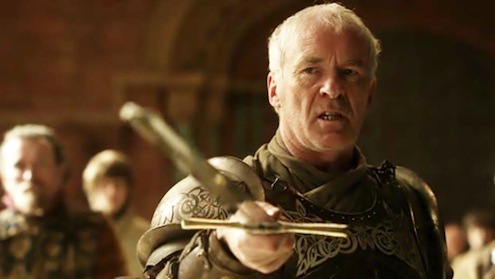
As knightly nicknames go, it doesn’t get much more straightforward than Ser Barristan the Bold: he famously earned his moniker at the tender age of ten, competing as an undersized mystery knight against Prince Duncan Targaryen, who was much impressed with the boy’s courage (with good reason, as it eventually turned out). We’re told that Garlan Tyrell, on the other hand, became known as Garlan the Gallant as an untested, pudgy youngster, when his older brother Willas recognized the PR value of a chivalrous epithet and strategically gave him the name before anything less complimentary could stick. Happily, Garlan grew out of his awkward stage and lived up to the hype (and presumably Willas went unchallenged for Highgarden’s Best Older Brother Award that year, because what a guy, right?).
And then you have characters like Daenerys Targaryen, who collects titles, epithets, and honorifics like it’s going out of style—although to be fair, she also inherited quite a few. By birth she is Daenerys Stormborn, Queen of the Andals and the Rhoynar and the First Men, Lord of the Seven Kingdoms; by marriage she is Khaleesi of the Great Grass Sea, and as a conqueror she is Queen of Meereen; she’s also been called The Mother of Dragons, The Unburnt, The Silver Queen, Daughter of Death, Slayer of Lies, Mother/Mysha, and so on.
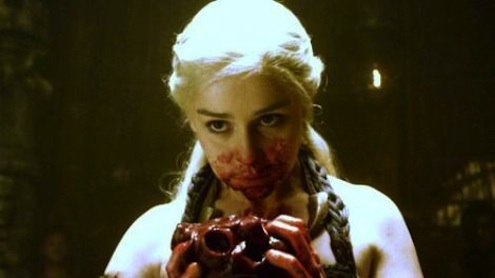
Personally, as much as I enjoy all the pomp and circumstance involved in celebrating the fact that Dany wears only the Fanciest of Pants and Is Truly Not To Be Messed With, my favorite names in this series are the ones that aren’t calculated to impress as much as they are descriptive, names that capture an aspect of a character’s personality or history. Nicknames tend to highlight difference, focusing on particular elements that set the bearer apart, for good or for ill—and what’s fascinating to me is the way these characters deal with being marked as unusual or somehow extraordinary (whether that entails being a freak or pariah, or simply out of sync with the status quo, odd, an unknown quantity). For example, for all the mockery that Brienne endures from those who would style her “Brienne the Beauty,” the ridicule heaped on her appearance and manner only fuels her determination to seek honor as a true knight—whereas one character might bitterly accept such expressions of derision, someone else might defiantly embrace a similar insult, born out of fear or contempt, as a warped badge of honor.
The list below looks at just a few of the more memorable character nicknames currently in play in Game of Thrones and the Song of Ice and Fire series. Admittedly, some of these names resonate with me because they add intricate depth and shading to already complex characters, while some of them are on the list because they are simply too entertaining to not be on the list. I also want to be clear that this is not intended to be an exhaustive survey, by any means, and I hope you’ll add your own favorites in the comment thread below…
The Clegane Boys: The Mountain That Rides vs. The Hound
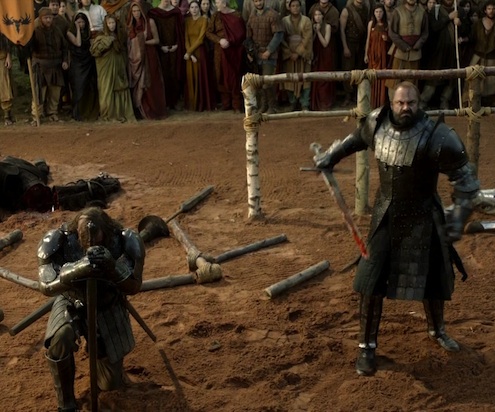
It’s interesting to compare the brothers’ nicknames: Gregor’s tells us, above all else, that he is LARGE. He’s a giant of a man, close to eight feet tall—a Goliath, a Collosus, a terrifying Brobdingnagian marvel in plate armor. We get it, loud and clear, but what’s more interesting is the idea of The Mountain as an inert, unfeeling mass hurtling toward you—something monstrous and unnatural and unknowable, which captures the essence of the character rather well.
Sandor, on the other hand, elicits both fear and sympathy in his role as the Hound. When he is introduced as Joffrey’s loyal henchman, he seems at least as vicious as his master, but (as with so many characters in this series) a much more complex and compelling personality comes to light as events unfold and we learn more about him. Abused, tormented, self-loathing, and relentlessly cynical, Sandor still exhibits more of a moral code and basic humanity (particularly toward the Stark girls) than most of the denizens in King’s Landing. He is capable of both pity and mercy in a hostile world that has shown him very little of either quality, which makes the Hound one of the most heartbreaking characters to follow, as he tries to become the master of his own fate.
The Queen of Thorns
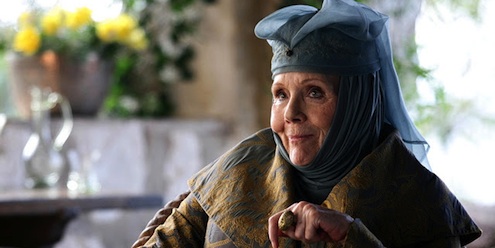
I suppose that one could view Lady Olenna Tyrell’s nickname in a negative light, as mocking or judgmental, petty backlash against a woman known for speaking her mind without mincing words. And yet I can’t quite see it that way—Olenna is an incredibly formidable woman, too intelligent and too influential to be a target of bush-league name-calling. To me, the nickname reads as something between a wary compliment and a warning—she is, after all, a regal presence (even though she would have preferred to avoid playing the game of thrones altogether, thanks for nothing, Mace Lord Puff Fish). She certainly has no qualms about mixing it up with Tywin Lannister, much less Cersei, and generally getting her way—and besides getting some of the most entertaining lines in the books/show, she’s a legitimately dangerous, even deadly, opponent. As nicknames go, not only is this one incredibly apt, but she owns it—underestimate The Queen of Thorns at your own risk.
Kingslayer
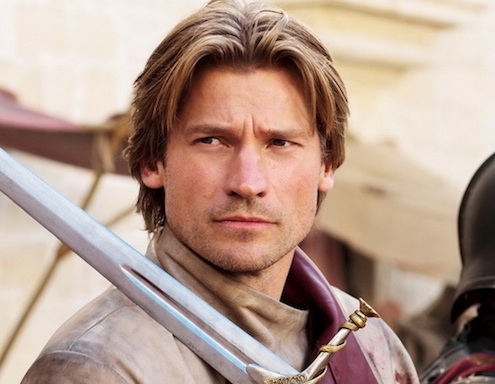
The evolution of Jaime Lannister from his introduction as an amoral would-be-child murderer to a complex and legitimately heroic POV character (starting in A Storm of Swords) is arguably one of the series’ greatest accomplishments to date. Our understanding of his character is inextricably tied to his reputation as “The Kingslayer”—the truth behind the nickname reveals the heart of the character, and the more we learn about the events that earned him the name, the more terrible weight and meaning it acquires.
Jaime treasonously slew King Aerys at the foot of the Iron Throne, although he had sworn a sacred oath to protect the king as a member of the Kingsguard—for that reason, even those in rebellion against the Targaryens tend to look upon Jaime with disgust and horror. Once we’re given insight into Jaime’s side of the story—the King’s madness, his delight in torture and sadism, his insane plan to burn King’s Landing to the ground—we understand why he considers the murder his finest accomplishment. The name becomes something of a badge of honor, though he remains a pariah, resigned to being hated and misunderstood (something he shares with his brother, Tyrion.) Jaime is hardly an innocent, and he has certainly done terrible things (we’re not forgetting about you, Bran, I promise), but his status as “Kingslayer” serves as a constant reminder that nothing in Westeros is ever as black and white as it might seem.
The Imp
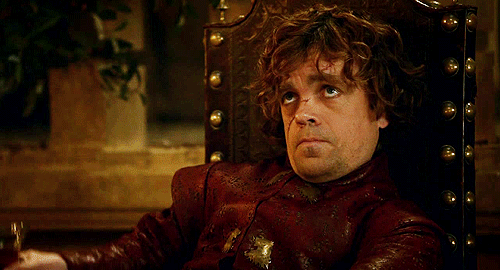
Tyrion’s nickname represents a perfect storm of derision, dismissal, condescension, and fear. The Imp is both not to be taken seriously and to be seriously mistrusted: as a dwarf, his physical appearance is generally interpreted as a sign that Tyrion is evil and/or inhuman, despite all evidence to the contrary. It is simultaneously a deeply mocking and deeply superstitious sobriquet, perfect for frightening the ignorant and powerless (or anyone else superstitious enough to believe in the existence of imps as supernatural or demonic beings) on one hand, and for belittling Tyrion in the eyes of the great and powerful and jaded, on the other. And then, of course, there’s the irony—at work on multiple levels—centered around the fact that at the same time nobles and smallfolk alike are demonizing Tyrion as some kind of unnatural creature, most people not only refuse to believe in the actual, literal monsters threatening the Seven Kingdoms, they also fail to see that there are far more savage, destructive entities on the loose within the walls of King’s Landing, hiding in plain sight (cut to crazy Joffrey smirking, twirling a crossbow…)
Littlefinger
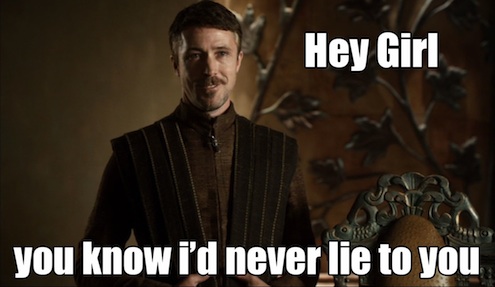
It’s rather telling that Petyr Baelish’s sobriquet originated with a joke of Edmure Tully’s—his foster brother and social superior, but also a bit of a well-meaning dullard. The name reflects the scarcity of his family’s holdings on the smallest of the stony, barren Fingers in the Vale of Arryn, and in that sense, it is a constant reminder of his modest beginnings, the relative unimportance of his lineage, and his general inferiority among the aristocracy of the Seven Kingdoms. Yet Baelish has risen to astonishing heights of power and influence, and his success is due in large part to his habit of encouraging those around to underestimate him, to not take him seriously, to rely complacently on the niceties of social order while all the time he undermines it, plotting and reveling in the chaos he creates, unseen and largely unsuspected.
Arya Underfoot
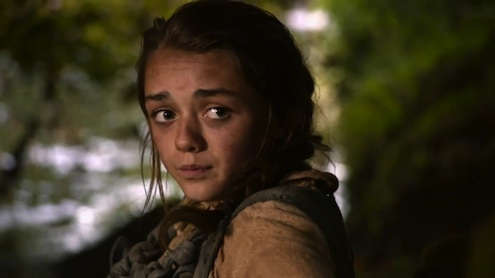
I don’t think this nickname of Arya’s got very much play in the HBO series (if any), and yet it is the one name, out of all of her assorted pseudonyms and aliases (“Arya Horseface,” “Arry,” “Nymeria/Nan,” “Salty,” “Cat of the Canals,” etc., etc.), that never fails to hit me with a little gutpunch of sympathy every time it comes up. Even when used in exasperation by the servants and staff of Winterfell, it remains an expression of affection for the spirited little girl who is never where she is supposed to be, always wandering off, getting into mischief, and pestering everybody instead of behaving like a quiet little lady. There’s a certain irony about the fact that the girl who was constantly underfoot has been separated from her home and family for so long, often just barely missing being reunited with her kin by combination of coincidence and bad timing. But more than that, the name makes me nostalgic for the child that Arya used to be, before the relentless tide of tragedy and trauma and horror began to sweep her further and further away from anything resembling comfort, stability, or safety.
Hot Pie
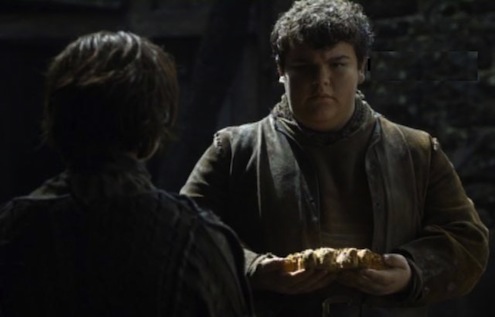
Hot Pie gets an honorable mention here only because he always seems so confused and out of his depth, like he randomly wandered out of some other series where people don’t die violently every few minutes. Even his name seems out of place: if Game of Thrones were a sitcom, Hot Pie would be the Lumpy Rutherford, the Potsie, the Tootie, if you will…he would be the Sixx to Arya’s Blossom, the Buddy to her Charles in Charge. Oh, Hot Pie—I can’t believe you’re still alive. Good on you.
The Red Viper and the Sand Snakes
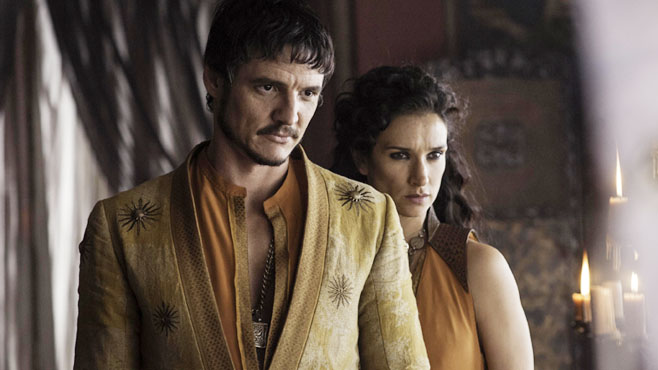
Why does Dorne have the best nicknames? Those following the HBO series loved (and mourned) The Red Viper (sexy-as-hell badass Prince Oberyn Martell) this season; his eight (8) sexy-as-hell badass illegitimate daughters are known collectively as the Sand Snakes, some of whom will show up in season 5. Here’s the dirt: at the age of sixteen, Prince Oberyn was discovered in bed with the paramour of Lord Edgar Yronwood, and subsequently wounded Lord Edgar in a duel. After Lord Edgar died, it was widely rumored that Oberyn had fought with a poisoned blade, earning the prince his sinister moniker, and his infamy was only bolstered in later years as he gained a reputation for his vast knowledge of poisons (and possibly the darker arts). Clearly, Oberyn knew how to make a bad reputation work in his favor—he’s like the Joan Jett of Westeros, in that regard—and while vengeance and bad blood are nothing new in the world of Game of Thrones, I’m very much looking forward to watching the Red Viper’s intimidating brood slithering toward payback in style.
[Warning: the characters discussed below have not yet appeared on HBO’s Game of Thrones. There are no overt spoilers about the fate of the characters themselves, but if you haven’t read the books and want to steer clear of information about what’s to come, stop reading here.]
Lady Stoneheart

We’ve discussed it, and if the rest of the Tor.com staff and I ever start a glam/metal band, we are definitely calling ourselves “Lady Stoneheart.” Maybe it’s because my brain always wants to confuse Lady Stoneheart with Bowie’s “Lady Stardust”—to be fair, I can certainly imagine Lady Stoneheart singing songs of sadness and dismay, although admittedly, Lady Stoneheart probably doesn’t do a lot of singing, what with her whole weird…throat…thing. Also, she’s kind of busy wreaking vengeance upon her enemies, and all enemy-adjacent parties, and people who maybe might have maybe met her enemies once, plus anybody who even remotely reminds of her of an enemy. She’s not picky, when if comes to vengeance, is what I’m saying. Fasten your seatbelts.
Coldhands

Hm. As far as band names go, I’d say “Coldhands” has more of an emo vibe than anything else on the list; I’m imagining lots of perfect, lustrous bangs and infinite sadness. On the other hand, he rides around on a giant elk like some kind of awesome undead Thranduil-from-the-dark-side, which is pretty badass. He’s mysterious and helpful (which is the best kind of mysterious), and so it makes sense that we know him by a name that’s probably the least terrifying thing you could possibly call a becloaked, raven-controlling undead guy with black, swollen hands who keeps his face hidden at all times and smells vaguely of rot. I suppose it will have to do until we finally find out who he really is… (Hint: it is probably not Bruce Wayne. Although, who knows?)
Bonus Round: Great Bastard Edition [Warning: spoilers through A Dance with Dragons below, as well as in the comments.]
Bloodraven (Lord Brynden Rivers) vs. Bittersteel (Aegor Rivers)

Bittersteel, whose name pretty much explains itself (he was apparently an unusually embittered, angry man, but also a fierce warrior), fled Westeros in disgrace following the rebellion and became a mercenary, eventually founding the Golden Company. Bloodraven (so-called because of the red, vaguely raven-shaped birthmark on the right side of his face) was an expert bowman and spymaster, with a reputation as a powerful sorcerer, who served as both Hand of the King and Lord Commander of the Night’s Watch under different Targaryen kings.
 He was also a one-eyed albino who went about cloaked and hooded to protect him from the light and (spoilers for A Dance with Dragons), he lives on as the three-eyed crow that appears to Bran Stark after his accident. When Bran and the Reeds finally reach his cave, Brynden appears not as a crow but as the last greenseer, a skeletal figure entangled in the roots of a weirwood tree who teaches Bran how to develop his own gifts as a seer. At this point in time, Bloodraven would be around 125 years old (but looks pretty great for his age, if you ignore the whole “weirwood roots poking through his bones and empty eyesocket” thing).
He was also a one-eyed albino who went about cloaked and hooded to protect him from the light and (spoilers for A Dance with Dragons), he lives on as the three-eyed crow that appears to Bran Stark after his accident. When Bran and the Reeds finally reach his cave, Brynden appears not as a crow but as the last greenseer, a skeletal figure entangled in the roots of a weirwood tree who teaches Bran how to develop his own gifts as a seer. At this point in time, Bloodraven would be around 125 years old (but looks pretty great for his age, if you ignore the whole “weirwood roots poking through his bones and empty eyesocket” thing).
All I know is, if some promoter would throw a totally unnecessary umlaut over one over the vowels in “Bloodraven” and book Bittersteel as an opening act, I can’t be the only one who would show up, lighter in hand, to see them play the Meadowlands, am I right? Or maybe not.
There are still plenty of nicknames left to discuss (and I didn’t even touch on any of the name-related in-jokes and homages that Martin weaves into the text, which is really a whole separate topic), so please share your own favorites, alternate interpretations, and potential bandnames in the comments…
Coldhands art by EvaMarieToker on deviantART
Bittersteel and Bloodraven art by Amoka.
Top image taken from imgur.
This post originally appeared March 31, 2014 on Tor.com.
Bridget McGovern is the managing editor of Tor.com. She does not have a proper nickname but if things go according to plan, she will one day be known, and feared, as The Widow von Doom.










